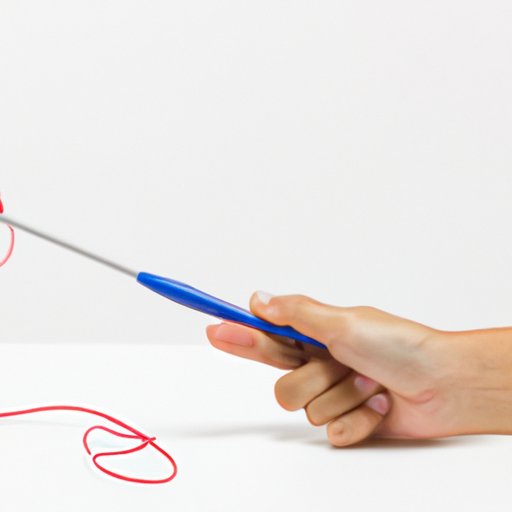
Introduction
Do you find yourself mindlessly fidgeting with your pen during class or work meetings? Why not take it up a notch and learn how to spin it? Pen spinning is a fun and satisfying activity that can improve your hand-eye coordination and focus. In this article, you’ll learn the basics of pen spinning, some advanced tricks, and how this activity can benefit your cognitive abilities.
A Step-by-Step Guide on How to Spin a Pen for Beginners
Before learning any tricks, let’s start with the basics of pen spinning. First, you need to hold the pen correctly. Place the pen between your thumb and index finger, with the middle finger supporting it from underneath. Keep your fingers tightly gripped on the pen and position your hand at a slight angle. The pen should be resting on your middle finger, with the tip pointing up.
Now that you’re holding your pen correctly, it’s time to learn the basic rotational motion. Start by flicking your middle finger upward to spin the pen between your thumb and index finger. As the pen rotates around your thumb and back to your index finger, use your ring finger and pinky to add some momentum to the spin. Repeat this motion until you’re comfortable with the pen’s rotation.
To master the spin, you’ll need to practice consistently. Experiment with different grips and angles to find what works best for you. You can even incorporate some of the advanced tricks (which we’ll cover next) into your practice routine to improve your spinning skills.
The Benefits of Pen Spinning and How It Can Improve Your Cognitive Abilities
Believe it or not, pen spinning can actually benefit your cognitive abilities. By practicing this activity, you can improve your hand-eye coordination, dexterity, and mental focus. This can, in turn, lead to improved academic or professional performance.
In fact, there are scientific studies that support the benefits of pen spinning. One study found that practicing pen spinning can have positive effects on the prefrontal cortex of the brain, which is responsible for executive functions like attention span and working memory. Another study showed that practicing fine motor skills like pen spinning can help improve ADHD symptoms.
Different Pen Spinning Tricks to Impress Your Friends and Colleagues
Now that you’ve mastered the basic spin, it’s time to move on to some more advanced tricks. Here are a few different tricks to try:
- ThumbSpin: Start with the basic spin, but as the pen rotates around your thumb, use your middle finger to push the pen down and spin it around your thumb. This trick takes some practice, but it’s a great one to master.
- Charge: This trick involves tossing the pen in the air and catching it while it spins. Start by holding the pen horizontally between your thumb and middle finger. Flick your thumb up to launch the pen into the air, and then catch it as it rotates.
- Sonic: Begin with the ThumbSpin, but instead of catching the pen, use your index finger to guide it back to your starting position. This creates a smooth transition between the two fingers.
These are just a few of the many tricks in the world of pen spinning. As with any skill, start with the basics and work your way up to the more advanced tricks. Practice makes perfect!
How to Properly Select and Grip a Pen for Optimal Spinning
Not all pens are created equal when it comes to pen spinning. Some pens are too heavy, too light, or too thick to spin effectively. The pen you choose should be light and balanced, with a smooth surface that allows for easy rotation.
Most pen spinners prefer using a pen with a cap, as it provides more balance and control. Some popular pen choices include the Pilot G2, Pentel RSVP, and Uni-ball Signo DX. Experiment with different pen types to find the perfect one for you.
The History and Origins of Pen Spinning and Its Evolution as an Art Form
The origins of pen spinning are uncertain, but many believe it started in Japan in the 1970s as a way for students to fidget during class. Over time, pen spinning evolved from a simple fidgeting activity to a recognized art form.
Pen spinning has a growing community of enthusiasts and even has its own world championship, where competitors show off their spinning skills and creativity.
Interview with a Pen Spinning Expert and Their Tips for Perfecting Your Pen Spinning Skills
We interviewed John, a pen spinning expert and enthusiast, about his experience with pen spinning and his tips for perfecting your technique.
Q: How did you get into pen spinning?
A: I started pen spinning back in high school as a way to relieve stress. I quickly fell in love with the activity and have been spinning ever since.
Q: What’s your favorite pen spinning trick?
A: My favorite trick is the “Shadow,” which involves spinning the pen around your hand in a circular motion. It’s a bit tricky to master, but it looks cool once you get it down.
Q: What tips do you have for beginners?
A: Don’t get discouraged if you don’t get it right away. Pen spinning takes time and patience to master. Start with the basic spin and work your way up to more advanced tricks. Also, don’t be afraid to ask for help or advice from other pen spinners. We’re a friendly community and are always happy to share our knowledge.
Conclusion
In conclusion, learning how to spin a pen is a fun and rewarding activity that can benefit your cognitive abilities and focus. Start with the basics, experiment with different pens, and work your way up to advanced tricks.





